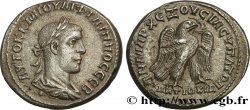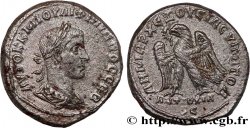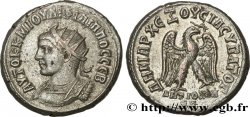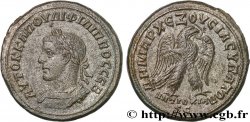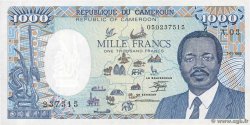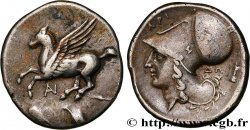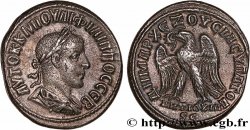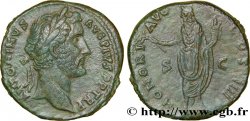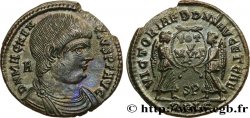bpv_154060 - PHILIPPUS II Tétradrachme syro-phénicien
недоступный.
Товар уже продан в нашем интернет-магазине (2014)
Цена: : 190.00 €
Товар уже продан в нашем интернет-магазине (2014)
Цена: : 190.00 €
Тип Tétradrachme syro-phénicien
Дата: 248
Монетный двор / Город: Antioche, Syrie, Séleucie et Piérie
Металл: billon
Диаметр: 28,00 mm
Ориентация осей монеты: 11 h.
Вес: 12,35 g.
Редкость: R2
Комментарии о состоянии
Pas d’usure sauf très légèrement sur la tempe et le ventre de l’aigle, bon centrage et frappe franche
Ссылки в каталоге: :
Происхождение:
Cet exemplaire est le 0403_015 de la base TSP
Лицевая сторона
Аверс: описание: Buste lauré, drapé, peut-être cuirassé de Philippe II auguste à droite, sans ptéryges à l’épaule mais une sorte de coque lisse (l’épaule elle-même ?),vu de trois quarts en avant (A0*1).
Аверс: легенда: AUTOK K M IOUL FILIPPOS SEB, (Autokratoros Kaisaros Markos Ioulios Filippos Sebastos)
Аверс: перевод: (L’empereur césar Marc Jules Philippe auguste).
Обратная сторона
Реверс: легенда: ANTIOXIA / S|C À L’EXERGUE.
Реверс: Описание: Aigle debout à gauche, les ailes largement déployées, tête à gauche et queue à droite, tenant une couronne feuillée dans son bec.
Реверс: легенда: DHMARC - EX OUSIAS UPATOG
Реверс: перевод: (Revêtu de la puissance tribunitienne / Consul pour la troisième fois / avec l’accord du Sénat d’Antioche).
Комментарий
A noter que la correction de la description de ce type dans le Prieur signalée par Richard McAlee est pertinente : l’épaule ronde sans ptéryges indique qu’il n’y a pas de cuirasse sous le drapé. On trouve un tel cas particulier dans les émissions de son père et on peut supposer ces émissions dédiées à un dieu particulier pour qui les attributs militaires étaient proscrits.
L’évolution des portraits de Philippe II au 3e consulat va du césar tête nue, à droite ou à gauche, à toute la gamme des bustes militaires, laurés ou radiés, avec la titulature d’auguste.
Il faut noter qu’aucun buste lauré n’est connu avec la titulature de césar, alors que radiés et laurés sont également répartis avec la titulature d’auguste. On peut en déduire que la tête laurée est indiscutablement liée aux augustes, et la tête nue aux césars, alors que la couronne radiée n’a pas de spécificité politique.
En abordant les frappes du 3e consulat, on remarque l’absence complète de frappes datées du deuxième consulat, bien que le deuxième consulat de Philippe et de sa famille existe indubitablement à Rome, y compris sur les émissions monétaires. Interruption des frappes ou comput différent à Antioche qu’à Rome ? Nous penchons pour la deuxième solution, pour deux raisons.
Tout d’abord la continuité stylistique : tant pour les revers que pour les droits, il n’y a pas de rupture, alors que l’on aurait pu présumer une certaine normalisation après une interruption des frappes. De plus, celle-ci se produira effectivement pour les frappes datées du quatrième consulat avec un style d’aigle unique, suivie à la fin par une nouveauté encore plus marquante, l’introduction d’officines indiquées sur les monnaies.
Ensuite, il existe à Antioche de très nombreuses frappes datées d’un quatrième consulat de Philippe l’Arabe dont nous ne trouvons pas trace à Rome. Il est extrêmement regrettable que les quelques informations dont nous disposons sur le Sénat d’Antioche soient largement plus tardives (4e et 5e siècle) car les émissions de tétradrachmes laissent à penser que non seulement le Sénat d’Antioche manifestait son indépendance envers Rome en frappant de l’argent avec la titulature “SC / ANTIOXIA” mais encore qu’il avait son propre comput impérial sous Philippe.
L’apparition de cette exergue et la disparition de la palme sont caractéristiques des 3e et 4e consulat mais les styles des aigles ne se normaliseront qu’au 4e.
On note que les sigma sont gravés en C.
Dans la base TSP maintenue par Michel Prieur, vingt exemplaires sont maintenant répertoriés pour ce type, en musées Jérusalem ex Capharnaum et ANS.
Note that the correction of the description of this type in the Prior reported by Richard McAlee is relevant: the round shoulder without pteryges indicates that there is no armor under the drapery. Such a special case is found in his father's issues and we can assume that these issues were dedicated to a particular god for whom military attributes were prohibited..
The evolution of the portraits of Philip II during the 3rd consulate goes from the bare-headed Caesar, on the right or on the left, to the whole range of military busts, laureates or radiates, with the title of Augustus.
It should be noted that no laureate bust is known with the title of Caesar, while radiates and laureates are also distributed with the title of Augustus.. We can deduce that the laureate head is indisputably linked to the Augusti, and the bare head to the Caesars, while the radiate crown has no political specificity..
When approaching the strikes of the 3rd consulate, we notice the complete absence of strikes dated from the second consulate, although the second consulate of Philip and his family undoubtedly existed in Rome, including on monetary issues.. Was the minting interrupted or was the calculation different in Antioch than in Rome? We are inclined to choose the second solution, for two reasons..
First of all, stylistic continuity: for both the backhands and the forehands, there is no break, whereas one might have assumed a certain standardization after an interruption in the strokes. Furthermore, this will actually occur for the strikes dated from the fourth consulate with a unique eagle style, followed at the end by an even more striking novelty, the introduction of offices indicated on the coins..
Then, in Antioch there are many strikes dated to a fourth consulate of Philip the Arab, of which we find no trace in Rome.. It is extremely regrettable that the little information we have on the Senate of Antioch is much later (4th and 5th century) because the issues of tetradrachms suggest that not only did the Senate of Antioch demonstrate its independence from Rome by minting money with the title “SC / ANTIOXIA” but also that it had its own imperial computus under Philip.
The appearance of this exergue and the disappearance of the palm are characteristic of the 3rd and 4th consulate but the styles of the eagles will not become standardized until the 4th.
Note that the sigmas are engraved in C.
In the TSP database maintained by Michel Prieur, twenty examples are now listed for this type, in Jerusalem museums ex Capharnaum and ANS
L’évolution des portraits de Philippe II au 3e consulat va du césar tête nue, à droite ou à gauche, à toute la gamme des bustes militaires, laurés ou radiés, avec la titulature d’auguste.
Il faut noter qu’aucun buste lauré n’est connu avec la titulature de césar, alors que radiés et laurés sont également répartis avec la titulature d’auguste. On peut en déduire que la tête laurée est indiscutablement liée aux augustes, et la tête nue aux césars, alors que la couronne radiée n’a pas de spécificité politique.
En abordant les frappes du 3e consulat, on remarque l’absence complète de frappes datées du deuxième consulat, bien que le deuxième consulat de Philippe et de sa famille existe indubitablement à Rome, y compris sur les émissions monétaires. Interruption des frappes ou comput différent à Antioche qu’à Rome ? Nous penchons pour la deuxième solution, pour deux raisons.
Tout d’abord la continuité stylistique : tant pour les revers que pour les droits, il n’y a pas de rupture, alors que l’on aurait pu présumer une certaine normalisation après une interruption des frappes. De plus, celle-ci se produira effectivement pour les frappes datées du quatrième consulat avec un style d’aigle unique, suivie à la fin par une nouveauté encore plus marquante, l’introduction d’officines indiquées sur les monnaies.
Ensuite, il existe à Antioche de très nombreuses frappes datées d’un quatrième consulat de Philippe l’Arabe dont nous ne trouvons pas trace à Rome. Il est extrêmement regrettable que les quelques informations dont nous disposons sur le Sénat d’Antioche soient largement plus tardives (4e et 5e siècle) car les émissions de tétradrachmes laissent à penser que non seulement le Sénat d’Antioche manifestait son indépendance envers Rome en frappant de l’argent avec la titulature “SC / ANTIOXIA” mais encore qu’il avait son propre comput impérial sous Philippe.
L’apparition de cette exergue et la disparition de la palme sont caractéristiques des 3e et 4e consulat mais les styles des aigles ne se normaliseront qu’au 4e.
On note que les sigma sont gravés en C.
Dans la base TSP maintenue par Michel Prieur, vingt exemplaires sont maintenant répertoriés pour ce type, en musées Jérusalem ex Capharnaum et ANS.
Note that the correction of the description of this type in the Prior reported by Richard McAlee is relevant: the round shoulder without pteryges indicates that there is no armor under the drapery. Such a special case is found in his father's issues and we can assume that these issues were dedicated to a particular god for whom military attributes were prohibited..
The evolution of the portraits of Philip II during the 3rd consulate goes from the bare-headed Caesar, on the right or on the left, to the whole range of military busts, laureates or radiates, with the title of Augustus.
It should be noted that no laureate bust is known with the title of Caesar, while radiates and laureates are also distributed with the title of Augustus.. We can deduce that the laureate head is indisputably linked to the Augusti, and the bare head to the Caesars, while the radiate crown has no political specificity..
When approaching the strikes of the 3rd consulate, we notice the complete absence of strikes dated from the second consulate, although the second consulate of Philip and his family undoubtedly existed in Rome, including on monetary issues.. Was the minting interrupted or was the calculation different in Antioch than in Rome? We are inclined to choose the second solution, for two reasons..
First of all, stylistic continuity: for both the backhands and the forehands, there is no break, whereas one might have assumed a certain standardization after an interruption in the strokes. Furthermore, this will actually occur for the strikes dated from the fourth consulate with a unique eagle style, followed at the end by an even more striking novelty, the introduction of offices indicated on the coins..
Then, in Antioch there are many strikes dated to a fourth consulate of Philip the Arab, of which we find no trace in Rome.. It is extremely regrettable that the little information we have on the Senate of Antioch is much later (4th and 5th century) because the issues of tetradrachms suggest that not only did the Senate of Antioch demonstrate its independence from Rome by minting money with the title “SC / ANTIOXIA” but also that it had its own imperial computus under Philip.
The appearance of this exergue and the disappearance of the palm are characteristic of the 3rd and 4th consulate but the styles of the eagles will not become standardized until the 4th.
Note that the sigmas are engraved in C.
In the TSP database maintained by Michel Prieur, twenty examples are now listed for this type, in Jerusalem museums ex Capharnaum and ANS







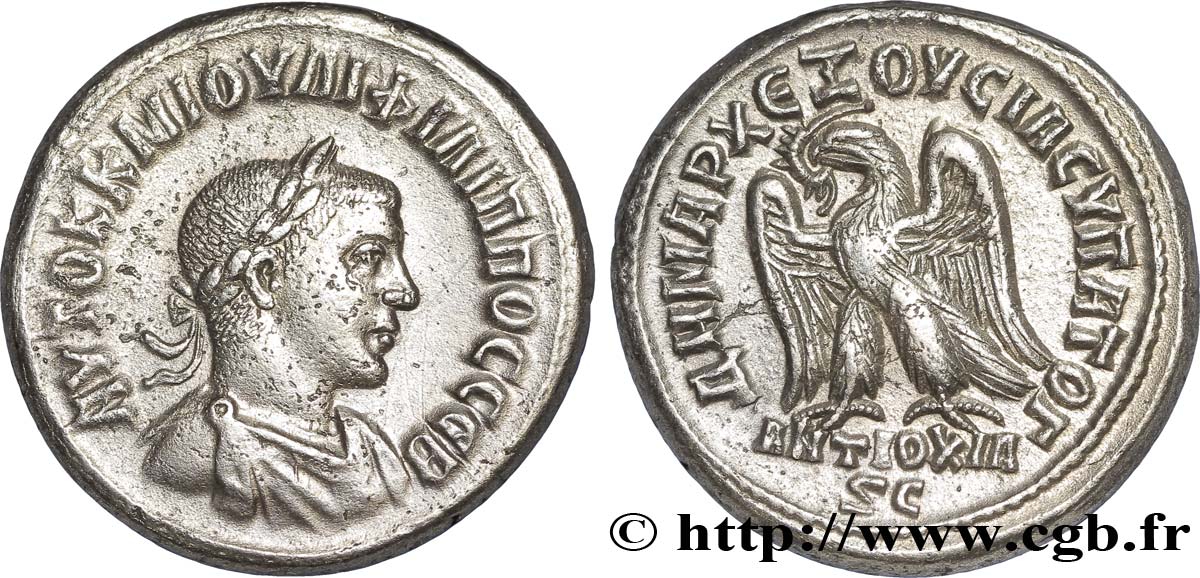
 Cообщить об ошибке
Cообщить об ошибке Распечатать страницу
Распечатать страницу Отправить мой выбор
Отправить мой выбор Задать вопрос
Задать вопрос Consign / sell
Consign / sell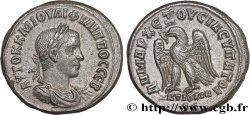
 Информация
Информация